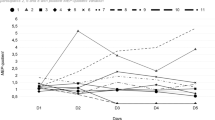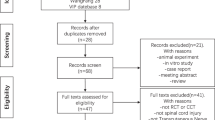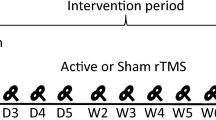Abstract
Study design: Double blind, partial crossover.
Objectives: To evaluate the analgesic activity of a novel cranial electrostimulus in people with spinal cord injury (SCI).
Setting: Hereward College, a residential centre that provides educational facilities for students with disabilities.
Methods: Subjects with SCI experiencing chronic pain were randomly assigned into two groups, one of which received sham and the other transcranial electrostimulation treatment (TCET) on two occasions daily for four successive days. After a `wash-out' period of 8 weeks all subjects returned and received the identical stimulus that the treated cohort received on the first arm of the study.
Results: Pain measurements applied before and after each session indicated that the pain decreased in the treated group to 51% of that reported at the commencement of treatment; reported pain intensity did not decrease significantly in the sham treated subjects. The same (sham) subject group reported experiencing 59% of the pain at the end of the second arm of the study (TCET) as on the first arm (sham). No significant differences were determined between the mood of all subjects estimated before and after each sham or TCET treatment session. The reported analgesic, and combined antidepressant and anxiolytic drug use in subjects receiving TCET on the second arm of the study, was 46% and 53% respectively of the average pre-study drug use. No similar decrease in the use of the drugs was noted in the same subjects after sham treatment on the first arm of the study. Salivary cortisol determinations made prior to and after each sham and treatment session implicated this corticoid in the pain-relieving mode of action of the treatment, but could not be associated with any changes in mood. Subjects receiving TCET had significantly higher urinary 3-methoxy-4-hydroxy-phenylglycol (MHPG) output after the TCET treatment period than sham stimulation, implicating increased central noradrenaline (NA) metabolism in the observed effects.
Conclusion: The subjects reported less pain during, and immediately after receiving this transcranial treatment, although they were using less medication than when receiving sham treatment.
Similar content being viewed by others
Log in or create a free account to read this content
Gain free access to this article, as well as selected content from this journal and more on nature.com
or
References
Loeser JD & Melzack R . Pain: an overview. The Lancet 2001; 357: 1607–1609.
Besson JM . The neurobiology of pain. The Lancet 1999; 353: 1610–1615.
Eide PK . Pathophysiological mechanisms of central neuropathic pain after spinal cord injury. Spinal Cord 1998; 36: 601–612.
Siddal PJ & Loeser JD . Pain following spinal cord injury. Spinal Cord 2001; 39: 63–73.
Finnerup NB et al. Pain and dysethesia in patients with spinal cord injury: A postal survey. Spinal Cord 2001; 39: 256–262.
Ravenscroft A, Ahmed YS & Burnside IG . Chronic pain after SCI. A patient survey. Spinal Cord 2000; 38: 611–614.
Stormer S et al. Chronic pain/dysaesthesiae in spinal cord injury patients: results of a multi-centre study. Spinal Cord 1997; 35: 446–455.
Hope ME & Kallis SG . Medication usage in a spinal cord injured population. Spinal Cord 1998; 36: 161–165.
Murphy D & Reid DB . Pain treatment satisfaction in spinal cord injury. Spinal Cord 2001; 39: 44–46.
Chapman CR & Gavrin J . Suffering: the contributions of persistent pain. The Lancet 1999; 353: 2233–2237.
Gerhart KA et al. Correlates of stress in long-term spinal cord injury. Spinal Cord 1999; 37: 183–190.
North NT . The psychological effects of spinal cord injury a review. Spinal Cord 1999; 37: 671–679.
Biering-Sørensen F & Biering-Sørensen M . Sleep disturbances in the spinal cord injured: an epidemiological questionnaire investigation, including a normal population. Spinal Cord 2001; 39: 505–513.
McQuay H . Opioids in pain management. The Lancet 1999; 353: 2229–2232.
Marchand S et al. Is TENS purely a placebo effect? – a controlled study on chronic low back pain. Pain 1993; 54: 99–106.
Vaarwerk IAT & Staal MJ . Spinal cord stimulation in chronic pain syndromes. Spinal Cord 1998; 36: 671–682.
Kupers RC et al. Spinal cord stimulation in Belgium – a nationwide survey on the incidence, indications and therapeutic efficacy by the health insurer. Pain 1994; 56: 211–216.
Cioni B et al. Spinal cord stimulation in the treatment of paraplegic pain. J Neurosurg 1995; 82: 35–39.
Braverman E et al. Modification of P300 amplitude and other electrophysiological parameters of drug abuse by cranial electrical stimulation. Current Therapeutic Res 1990; 48: 586–596.
Krupitsky EM et al. The administration of transcranial electric treatment for affective disturbances therapy in alcoholic patients. Drug and Alcohol Dependence 1991; 27: 1–6.
Philip P . Efficiency of transcranial electrostimulation on anxiety and insomnia symptoms during a washout period in depressed patients: a double-blind study. Biolog Psych 1991; 29: 451–456.
Wilson O et al. The influence of electrical parameters on the analgesia produced by low current transcranial electrostimulation of rats. J Anes Analg 1989; 8: 673–681.
Capel ID, Dorrell HM & Spencer EP . The application of sub-perception electrical stimuli elicits a temporally distinct response from restraint stress: I. antinociceptive characteristics. J Bioelectricity 1990; 9: 167–176.
Qiao JT, Skolnick MH & Dafny N . Dorsal raphe and external electrical stimulation modulate noxious input to single neurons in nucleus parafascicularis thalami. Brain Res Bull 1988; 21: 671–675.
Dong WQ et al. Hypothalamic, dorsal raphe and external electrical stimulation modulate noxious evoked responses of habenula neurons. Neurosci 1992; 48: 933–940.
Beck AT & Beck RW . Screening depressed patients in family practice: a rapid technique. Postgrad Med 1972; 52: 81–85.
Spielberger CD, Gorsuch RL & Lushene RE The state-trait anxiety inventory (STAI) – test manual for form X. Palo Alto: California Psychological Press, 1968.
Kirschbaum C & Hellhammer DH . Salivary cortisol in psychobiological research: an overview. Neuropsychobiol 1989; 22: 150–169.
Grossman F & Potter WZ . Catecholamines in depression: a cumulative study of urinary norepinephrine and its major metabolites in unipolar and bipolar depressed patients versus healthy volunteers at the NIMH. Psychiatry Res 1999; 87: 21–27.
Capel ID, Dorrell HM & Spencer EP . The application of sub-perception electrical stimuli elicits a temporally distinct response from restraint stress: II. Neurochemical considerations. J Bioelectricity 1990; 9: 177–186.
Melzack R . The short-term McGill pain questionnaire. Pain 1987; 30: 191–197.
Eysenk JH & Eysenk SBG . The Eysenk personality inventory. In: San Diego Educational and Industrial Testing Service. London: University of London Press, 1963.
Walker RF et al. Adrenal status assessed by direct RIA of cortisol in whole saliva or parotid saliva. Clin Chem 1978; 24: 1460–1463.
Taylor RB et al. Assay procedures for the determination of biogenic amines and their metabolites in rat hypothalamus using ion-pairing reversed-phase high-performance liquid chromatography. J Chromatog 1983; 277: 101–114.
Warnhoff M . Simultaneous determination of norepinephrine, dopamine, 5-hydroxytryptamine and their main metabolites in rat brain using high-performance liquid chromatography with electro-chemical detection: Enzymatic hydrolysis of metabolites prior to chromatography. J Chromatog 1984; 307: 271–281.
Kennedy P & Duff J . Post traumatic stress disorder and spinal cord injuries. Spinal Cord 2001; 39: 1–10.
Linton SJ, Skevington SM & Crombie IK et al.(eds). Psychological factors. In: Epidemiology of Pain a report of the Task Force on Epidemiology of the international Association for the Study of Pain. Seattle: IASP Press, 1999; pp 25–42.
Lango LP & Johnson B . Addiction: Part 1. Benzodiazepines – side effects, abuse risk and alternatives. Am Fam Physician 2000; 61: 2121–2128.
Cruess DG et al. Reductions in salivary cortisol are associated with mood improvement during relaxation training among HIV-seropositive men. J Behav Med 2000; 23: 107–122.
Roy A . Norepinephrine and its metabolites in cerebrospinal fluid, plasma and urine. Relationship to hypothalamic-pituitary-adrenal axis function in depression. Arch Gen Psychiatry 1988; 45: 849–857.
Garvey MJ & Tuason VB . Do low levels of MHPG in depressive spectrum patients normalise after successful treatment? Neuropsychobiol 1996; 34: 188–191.
Mellman TA et al. Nocturnal/daytime urine noradrenergic measures and sleep in combat-related PTSD. Biol Psychiatry 1995; 38: 174–179.
Hrobjartsson A & Gotzsche PC . Is the placebo powerless? New Engl J Med 2001; 344: 1594–1602.
Bowden CL et al. Changes in urinary catecholamines and their metabolites in depressed patients treated with amitriptyline or imipramine. J Psychiatr Res 1987; 21: 111–128.
Malin DH et al. Auricular microelectrostimulation; naloxone reversible attenuation of opiate abstinence syndrome. Biol Psych 1988; 4: 886–890.
Doughty PM et al. Trans-cranial electrical stimulation attenuates abrupt morphine withdrawal in rats assayed by remote computerised quantification of multiple motor behavioural indices. Europ J Pharmacol 1990; 175: 187–195.
Vassend O & Skrondal A . The role of negative affectivity in self assessment of health. J Health Psych 1999; 4: 465–482.
Acknowledgements
The authors are indebted to the Laing Foundation, Thera Trust and Smith’s Charity for financial assistance. The authors are also grateful to the excellent staff and for the facilities provided by Hereward College and to the Duracell Battery Company for assistance with equipment. Most of all, the authors gratefully acknowledge the contribution of the Spinal Injuries Association of the UK, and, in particular, the input of Mr Stephen Bradshaw, without whose help, advice and encouragement, this study would not have occurred.
Author information
Authors and Affiliations
Rights and permissions
About this article
Cite this article
Capel, I., Dorrell, H., Spencer, E. et al. The amelioration of the suffering associated with spinal cord injury with subperception transcranial electrical stimulation. Spinal Cord 41, 109–117 (2003). https://doi.org/10.1038/sj.sc.3101401
Published:
Issue date:
DOI: https://doi.org/10.1038/sj.sc.3101401
Keywords
This article is cited by
-
Response analysis of the piezoelectric energy harvester under correlated white noise
Nonlinear Dynamics (2017)
-
Power harvesting from transverse galloping of square cylinder
Nonlinear Dynamics (2012)
-
Phenomena and modeling of piezoelectric energy harvesting from freely oscillating cylinders
Nonlinear Dynamics (2012)
-
Global nonlinear distributed-parameter model of parametrically excited piezoelectric energy harvesters
Nonlinear Dynamics (2012)
-
Enhancement of power harvesting from piezoaeroelastic systems
Nonlinear Dynamics (2012)



